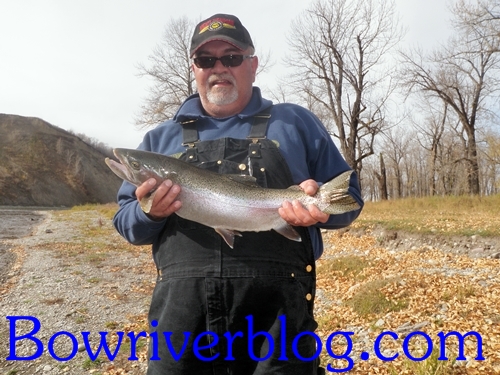[kml_flashembed movie="http://www.youtube.com/v/A7xIkE4xjMo" width="425" height="344" allowfullscreen="true" fvars="fs=1" /]
A Snowy Float Trip In October
Todd and I decided we were going fishing. I hit the tackle store for a few of my favorite lures and was all set to fish the next day. I awoke to a chilly cloudy morning that was not looking favorable to fish the Bow River. After hitting the coffee shop and returning home for my gear, snow was starting to fall before I reached my doorstep. I sent Todd a quick text message saying, “Still wanna go fishin”. He replied “will see, meet me for breakfast”. As we were munching on eggs and toast, the snow was getting heaver and more fell. We finished up and headed down to Policeman’s Flats to take a look at the river. “Let’s do it” Todd says to me. I’m thinking “what are you nuts” and also thinking “this could be an awesome day for fishing”. We bundled up, and I mean bundled up and launched the boat into the ice cold water. We hit the gas and down the river we went.
My hands we cold and wet as the snow fell harder with every passing minute. It felt like it was minus ten but the thermometer said only zero. The wind made it seem colder as we were flying down the river eager to get to the first trout producing hole. Todd cut the gas and we were fishing finally. What the heck am I doing? My hands were cold but I was warm, so I fired my lure into the back and ripped the Rapala back toward the boat. Nothing! Then as we were drifting I fired that Rapala back into the bank. It did not take long and I was scrapping a twenty inch Bow River Rainbow Trout. Yes sir that was the first of many fish to come. It seemed like every hole we fished, we caught.
After twelve noon the weather broke off and the sun came out. It was as if the fishing Gods were smiling down upon us. We were just coming into one of my favorite holes and then the river came alive. We hammered two trout simultaneously and the first double header was underway. My fish slipped away but Todd was able to land his, a nice Rainbow Trout. Again and again we hooked and landed rainbows. Just goes to show you that you never know what to expect in a days fishing!
A snowy cold morning turned into one of the best fishing days I have had this season. It was as though the rainbows came alive as the water temperature dropped a few degrees. We could have burned back up the hill and left Policeman’s Flats to return to the warmth of our houses, wondering if we would have caught fish. Well I’m glad we decided to fish instead of wonder! Watch the video and see the snow falling and the trout we landed!


